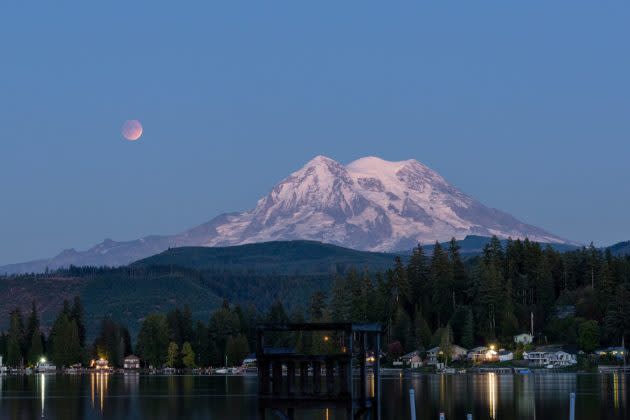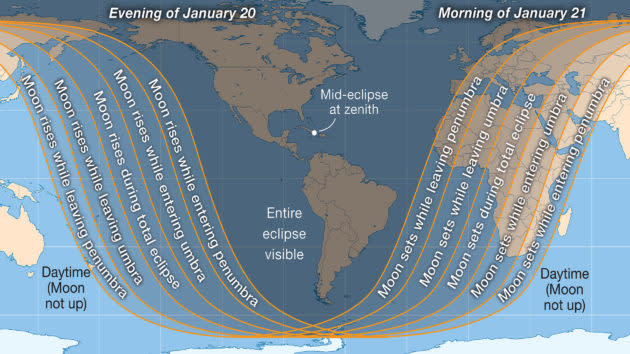All-American lunar eclipse will darken the moon and brighten spirits (if skies clear)

Are you ready for Sunday night’s “Super Blood Wolf Moon”? The good news is that North America is well-positioned to see a total lunar eclipse for the first time in nearly a year.
The bad news? If the skies are clouded over, it doesn’t matter.
That’s a particularly important caveat in Western Washington — where the weather outlook calls for considerable cloudiness and a 20 percent chance of rain.
Total lunar eclipses tend to be more widely seen than total solar eclipses, because when Earth comes between the sun and the full moon, our planet’s shadow is more than capable of darkening the moon’s entire disk. The sight is visible from any place where the skies are dark and clear, during a totally predictable period of time.
Because the moon’s orbit around Earth is slightly tilted with respect to Earth’s orbit around the sun, an eclipse doesn’t occur every time it passes behind our planet. The sun-Earth-moon alignment has to be just right to produce a total lunar eclipse from Earth’s point of view. That may happen once a year (as is the case in 2019), twice a year (as in 2018), or not at all in the course of a year (as in 2020).
NASA serves up a year-by-year list of total, partial and penumbral lunar eclipses.
Here are the key times for Sunday’s celestial event:
6:36 p.m. PT: Earth’s penumbral shadow begins to touch the edge of the moon’s disk, but the effect isn’t likely to be perceptible until about 7:10 p.m.
7:33 p.m. PT: Earth’s dark umbral shadow begins marching across the moon.
8:41 p.m. PT: Totality begins when Earth’s shadow covers the moon completely. Direct sunlight is blocked, but the refracted light of a million sunsets is bent by Earth’s atmosphere, casting a reddish, brownish or even grayish glow on the darkened disk. This is why some folks call a total lunar eclipse a “blood moon.” Others aren’t crazy about the phrase. “Anyone who says ‘blood moon’ must also know that the term has long gone out of fashion among the cool kids,” German science writer Daniel Fischer says.
9:44 p.m. PT: Totality ends when Earth’s umbral shadow begins its retreat.
10:51 p.m. PT: The moon emerges from Earth’s dark shadow and is dimmed only slightly by the penumbral shadow.
11:48 p.m. PT: The moon reverts completely to its regular full phase. The last perceptible hints of the penumbral eclipse are likely to fade from sight about a half-hour earlier than this, at about 11:15 p.m.
Because of the varying orbital positions of the moon in its orbit around Earth, this weekend’s full moon is closer to us than average, which means the moon looks bigger and brighter than average. By some definitions, it’s the first of three supermoons in 2019. I prefer to reserve that designation for the closest and brightest moon in a given year (which occurs in February this year). But that’s just me. In any case, this is where the “Super” in “Super Blood Wolf Moon” comes from.
The “Wolf Moon” comes from American folklore about the names given to each month’s full moon. January supposedly brings the Wolf Moon because Native Americans and early European settlers associated the sight with hungry wolves howling outside their villages.
If you’re hungry for the eerie sight of a total lunar eclipse, you have to keep the weather in mind. The National Weather Service’s outlook for Sunday night calls for cloud cover over most of Western Washington, so if you’re a Seattleite, your best bet may well be to watch the eclipse online.
Just in case you’re clouded out, here’s a lineup of lunar eclipse webcasts:
Griffith Observatory: Live! From Los Angeles! The observatory’s eclipse coverage starts at 5 p.m. PT Sunday.
Slooh: The online observatory will air a pre-game show at 8:30 a.m. PT today, with eclipse coverage due to start at 6 p.m. PT Sunday.
Astronomy Live Stream: A 4K video view of the moon from Denver is due to go online at 6 p.m. PT Sunday.
TimeAndDate.com: Tune in the webcast starting at 7 p.m. PT Sunday with live commentary by astrophysicist Graham Jones.
Astronomers Without Borders: The webcast begins at 7:30 p.m. PT Sunday with hosts Andrew Fazekas (the “Night Sky Guy”) and Peter Anthony Holder.
Exploratorium: The San Francisco museum is planning eclipse coverage on Facebook Live starting at 7:30 p.m. PT Sunday.
For what it’s worth, the next total lunar eclipse after this one comes on May 26, 2021. In 2022, we’ll get in on a double dose of lunar darkness. And if you can wait another two years after that, there’s a North American total solar eclipse to look forward to in 2024.
Update for 12:30 p.m. PT Jan. 20: We’ve updated this report with the latest weather forecasts, but check in with the National Weather Service, the Weather Channel or your favorite source of weather information for further updates over the weekend.
More from GeekWire:
A lunar wonder … or a washout? Your guide to the super blue blood moon eclipse
It’s prime time for watching Mars – plus a total lunar eclipse that you can see online
Moonless in Seattle? Feast your eyes on global views of the total lunar eclipse
Photographers get super views of ‘Super Blood Wolf Moon’ eclipse — even in Seattle

